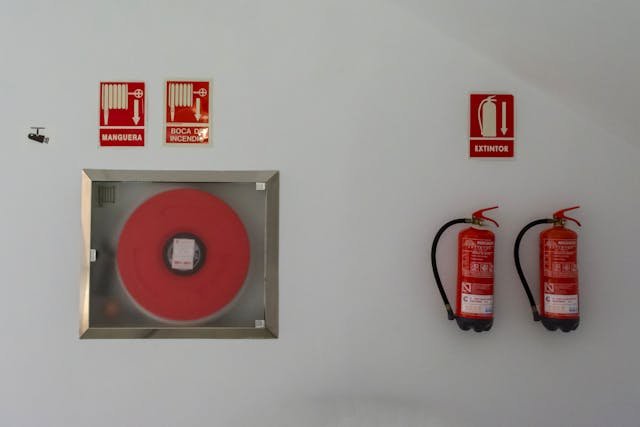Fire extinguishers are lifesavers, but what happens to them after they’ve served their purpose? Whether your extinguisher is expired, damaged, or has been used, knowing how to dispose of it properly is crucial for both safety and environmental reasons.
Improper disposal of fire extinguishers can pose serious hazards—from potential chemical leaks to dangerous pressure buildup in landfills. Simply tossing them in the trash is not only unsafe but also harmful to the environment.
In this guide, we’ll walk you through the correct and responsible ways to dispose of your fire extinguisher, including recycling options, hazardous waste collection sites, and manufacturer take-back programs. Let’s ensure your old extinguisher doesn’t become a hazard itself!

When to Replace Fire Extinguishers?
Fire extinguishers are essential safety devices, but they don’t last forever. Over time, they may lose pressure, become damaged, or simply reach the end of their lifespan. Knowing when to replace an old fire extinguisher is crucial for maintaining safety in homes, offices, and workplaces.
Signs That You Need to Replace a Fire Extinguisher
- Expiration Date – Most fire extinguishers last between 5 to 15 years. Check the manufacturer’s label to determine the exact lifespan.
- Pressure Gauge Issues – If the pressure gauge reads too low or too high, it may indicate a malfunction. A properly functioning extinguisher should be in the green zone.
- Physical Damage – Dents, rust, corrosion, or a broken handle can make the extinguisher unsafe to use.
- Leaking or Clogged Nozzle – If the nozzle is blocked or shows signs of leakage, the extinguisher may not function correctly in an emergency.
- Failed Professional Inspection – If a routine inspection by a fire safety professional deems the extinguisher unreliable, it’s time for a replacement.
- Used or Partially Discharged – Even if used just once, a fire extinguisher should be refilled or replaced, as its effectiveness may be compromised.
Preparing the Fire Extinguisher for Disposal
Proper fire extinguisher disposal ensures safety and environmental responsibility. Before discarding an old fire extinguisher, follow these steps to prepare it correctly.
1. Safety First
Before handling an old fire extinguisher, take necessary precautions to avoid accidents.
- Wear protective gloves and eyewear to prevent any exposure to leftover chemicals.
- Choose a well-ventilated area to safely discharge any remaining contents.
2. Discharge the Extinguisher
If the extinguisher is still pressurized, it must be emptied completely:
- Follow manufacturer instructions to discharge the remaining contents.
- Point the nozzle at an open, safe space (away from people and animals) and fully release the pressure.
- If the extinguisher was used but not emptied completely, ensure all remaining agents are discharged.
3. Release Pressure
Even after discharging, some residual pressure may remain.
- Carefully release any remaining pressure by pulling the pin and squeezing the handle until nothing comes out.
- Let the extinguisher sit for a while to ensure it is fully depressurized.
4. Remove Components
To facilitate proper disposal and recycling, separate the extinguisher’s components:
- Detach the hose and nozzle if possible.
- Remove the pressure gauge, as it contains sensitive parts.
- For some extinguishers, unscrew the head to indicate it’s no longer in use.

Step-by-Step Guide: How to Dispose of a Fire Extinguisher
Proper fire extinguisher disposal is important to prevent hazards and environmental damage. Follow this guide to safely dispose of a fire extinguisher, whether it is empty, full, or partially used.
1. Check If the Fire Extinguisher Is Empty or Full
Before disposing of an old fire extinguisher, determine whether it is still pressurized or completely empty.
How to Tell If a Fire Extinguisher Has Pressure Left
- Check the pressure gauge:
- If the needle is in the green zone, the extinguisher is still pressurized.
- If it is in the red or empty zone, it may be safe for disposal.
- Weigh the extinguisher: A full extinguisher will be heavier than an empty one.
- Gently shake it: If you hear or feel the extinguishing agent moving inside, it is not fully discharged.
Safety Precautions Before Disposal
- Always handle with care to avoid accidental discharge.
- Wear gloves and protective gear when dealing with old or leaking extinguishers.
- Never dispose of a pressurized extinguisher in the trash—it can explode under pressure.
2. Disposal of an Empty Fire Extinguisher
If the old fire extinguisher is completely empty, follow these steps:
Depressurizing the Unit Before Recycling
- Take the extinguisher outdoors to a well-ventilated area.
- Point the nozzle in a safe direction and squeeze the handle until no more contents come out.
- Let the extinguisher sit for a few hours to ensure it is fully depressurized.
Removing the Head/Nozzle for Proper Disposal
- If possible, unscrew and remove the head or nozzle to indicate that the unit is decommissioned.
- This step is required in some areas before taking the extinguisher to a recycling center.
Recycling the Metal Canister
- Most fire extinguishers are made of steel or aluminum and can be recycled.
- Check with local scrap metal recyclers or municipal waste facilities for proper disposal guidelines.
3. Disposal of a Full or Partially Used Fire Extinguisher
If the extinguisher is still full or has remaining contents, you cannot throw it in regular trash due to safety risks.
Why You Can’t Throw a Pressurized Extinguisher in the Trash
- A pressurized container can explode when compacted or exposed to heat.
- Fire extinguisher chemicals can be hazardous to the environment.
Safe Disposal Options
- Contact a Local Hazardous Waste Facility: They handle fire extinguisher disposal in accordance with environmental laws.
- Check With Your Fire Department: Some fire stations accept used extinguishers for proper disposal.
- Municipal Disposal Programs: Many cities offer recycling or hazardous waste collection programs.
Fire Extinguisher Recycling & Recharging Options
Not all fire extinguishers need to be thrown away. Some can be recharged and reused instead of replaced.
Refillable (Rechargeable) Fire Extinguishers
- If the unit is labeled “rechargeable,” you can refill it after use.
- Check the manufacturer’s guidelines to see when a recharge is necessary.
Where to Get Recharging Services
- Fire Equipment Suppliers – Many fire protection companies offer extinguisher recharging.
- Authorized Service Centers – Look for certified extinguisher maintenance providers.
Scrap Metal Recycling Centers
- If your old fire extinguisher is beyond repair, take the metal canister to a recycling center.
- Some centers require the canister to be emptied and depressurized before accepting it.
Special Disposal Cases: CO₂ and Chemical-Based Fire Extinguishers
Different types of fire extinguishers require specific disposal methods.
CO₂ (Carbon Dioxide) Fire Extinguishers
- Must be depressurized in a controlled environment to prevent dangerous gas release.
- Contact a fire equipment supplier or hazardous waste facility for proper disposal.
Dry Chemical Fire Extinguishers
- These contain chemical agents that can be harmful if inhaled or released improperly.
- Dispose of these units through certified hazardous waste programs.
Foam-Based Fire Extinguishers
- Foam extinguishers contain substances that can contaminate water supplies.
- Never pour the contents down the drain—take the unit to an authorized disposal center.
What NOT to Do When Disposing of Fire Extinguishers
Improper fire extinguisher disposal can pose serious risks to both safety and the environment. Avoid these common mistakes when handling an old fire extinguisher.
1. Never Puncture or Dismantle a Pressurized Unit
- A pressurized fire extinguisher can explode if punctured, leading to serious injury.
- Always ensure the extinguisher is fully discharged and depressurized before attempting any removal of parts.
2. Avoid Throwing Full Extinguishers in Regular Trash
- Pressurized containers can rupture when crushed or exposed to heat in a landfill.
- Some fire extinguishing agents contain chemicals that are hazardous to the environment.
- Instead, contact local waste management services for proper disposal of fire extinguisher units.
3. Why Fire Extinguisher Contents Should Not Be Drained Into the Sink
- Fire extinguisher agents, such as dry chemicals or foam, can clog drains and damage plumbing.
- Some chemicals are toxic to aquatic life and should never be washed down into the water system.
- Always follow manufacturer guidelines for proper disposal or take the extinguisher to a hazardous waste facility.
Proper fire extinguisher disposal is crucial for both safety and environmental responsibility. Whether dealing with an old fire extinguisher that is empty, full, or rechargeable, following the correct disposal methods prevents hazards and ensures compliance with local regulations. Always check if the extinguisher is pressurized before disposal, avoid puncturing or throwing it in regular trash, and never drain its contents into sinks or drains. Instead, use authorized recycling centers, hazardous waste facilities, or fire department disposal programs. Choosing refillable or eco-friendly extinguishers can further reduce waste and promote sustainability. By handling fire extinguishers responsibly, we contribute to a safer environment and a more efficient fire safety system.

Anamika is a passionate writer for Eco365Store.com, specializing in topics that inspire a cleaner, greener world. With expertise in home cleaning, recycling, and eco-friendly solutions, she crafts engaging and informative articles that help readers adopt sustainable practices in their daily lives.
